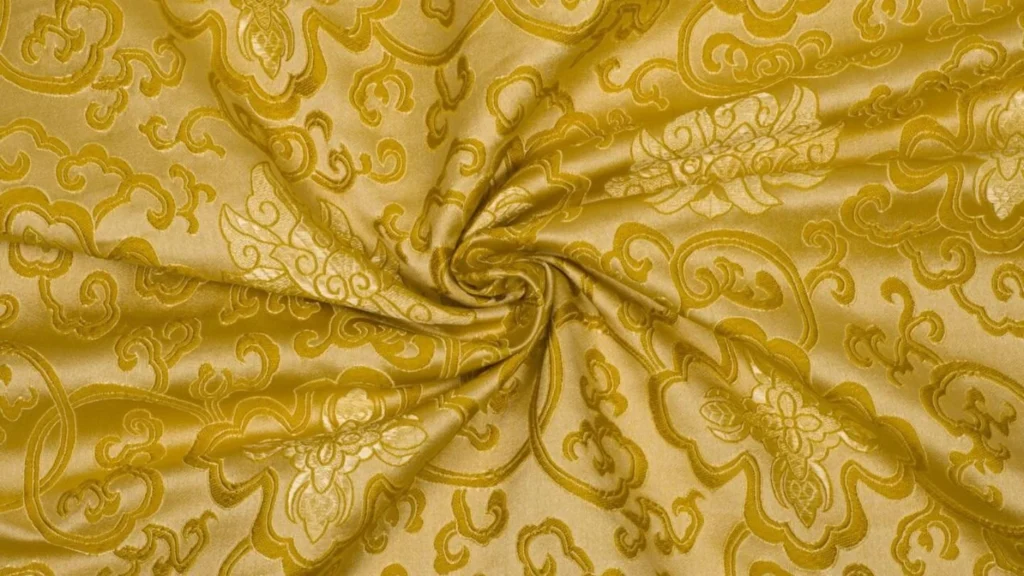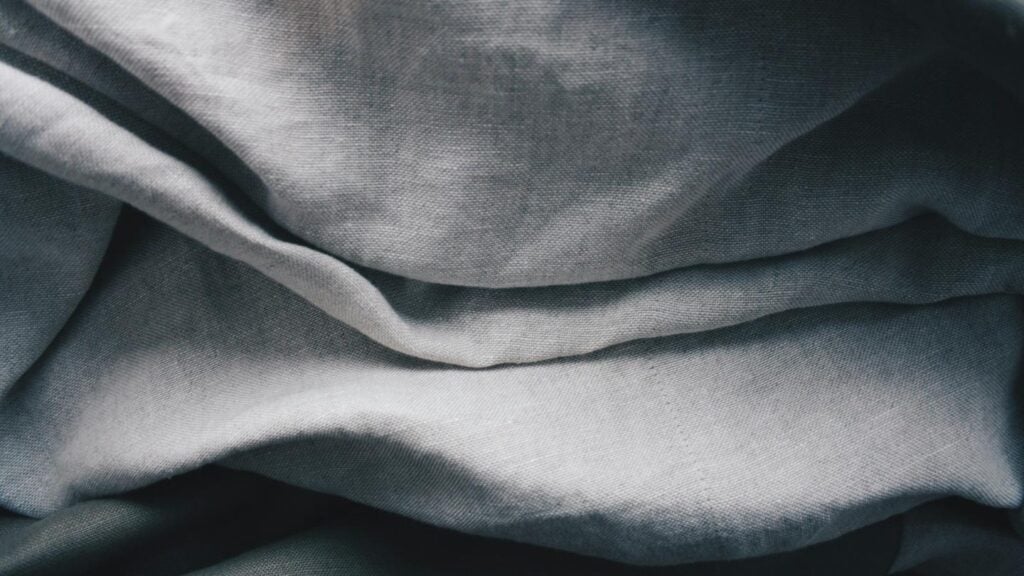2 – Ikat Fabric Composition
3 – Ikat Fabric vs Other Fabrics
4 – Ikat Fabric Is Manufactured
5 – Common Uses in Fashion
6 – Understanding the Environmental Impact of Ikat Fabric
7 – Exploring Price Points and Value for Money
8 – Conclusion
9 – FAQs
What is Ikat Fabric?
Ikat fabric is a unique and vibrant textile known for its intricate, dyed patterns that are created through a distinctive weaving technique. The word “Ikat” comes from the Malay and Indonesian word “mengikat,” meaning “to tie” or “to bind,” which perfectly describes the process of dyeing the yarns before they are woven into fabric. This method results in beautiful, blurry, and complex patterns that are characteristic of Ikat fabric. The technique involves tightly tying sections of yarn before dyeing them, ensuring that the dyed areas form the pattern once woven together.
Ikat fabric has been produced for centuries in various parts of the world, including Southeast Asia, India, Central Asia, and South America. Each region has its own version of Ikat, with distinct patterns and colors reflecting cultural heritage and craftsmanship. While it is traditionally handwoven and hand-dyed, modern industrial methods have allowed Ikat to become more accessible and used in contemporary fashion and home décor.

Key features of Ikat fabric include:
- Intricate Patterns: Ikat is renowned for its stunning, often blurred patterns created through the dyeing of the yarns.
- Cultural Significance: The techniques and designs vary by region, with each culture using Ikat to express its unique artistic and historical identity.
- Versatility: Ikat fabric can be used in a wide range of applications, from clothing and accessories to upholstery and interior design.
Ikat’s striking designs and rich history make it a timeless and valuable fabric, combining traditional craftsmanship with modern appeal.
Ikat Fabric Origin
Ikat fabric has a long history, with origins in Southeast Asia, Central Asia, and parts of India. The technique involves dyeing yarns before weaving them, creating intricate patterns. In Southeast Asia, particularly Indonesia, Ikat has been a symbol of prestige for centuries, while in India, it has been used in traditional garments for over 500 years. The technique also spread to South America, with countries like Guatemala and Mexico adopting it for traditional textiles.
Ikat Fabric Composition
Ikat fabric is primarily made from natural fibers, with cotton, silk, and wool being the most common materials used. The unique process of creating Ikat fabric begins with the dyeing of the yarn before weaving, which allows the fabric to showcase vibrant, intricate patterns. The fibers used are typically sourced for their ability to hold dye well, ensuring the clarity and richness of the Ikat designs.
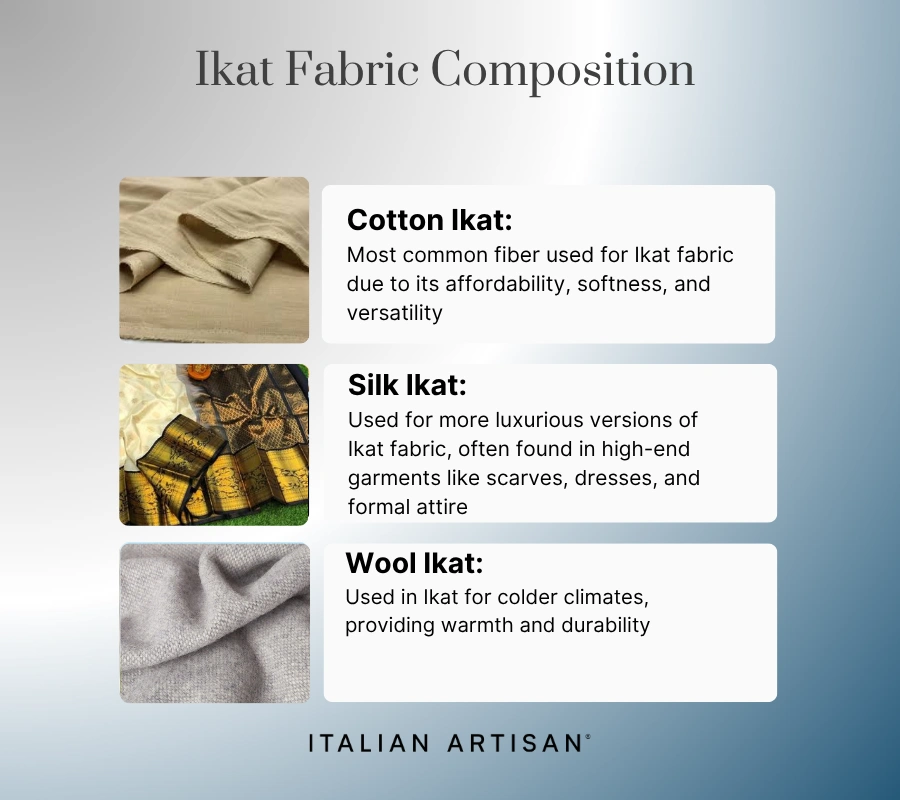
- Cotton Ikat: Cotton is the most common fiber used for Ikat fabric due to its affordability, softness, and versatility. It is often used for casual and everyday clothing, as well as home décor items like pillow covers and curtains.
- Silk Ikat: Silk is used for more luxurious versions of Ikat fabric, often found in high-end garments like scarves, dresses, and formal attire. Silk’s smooth texture adds a rich sheen to the fabric, enhancing the vibrancy of the patterns.
- Wool Ikat: Wool is used in Ikat for colder climates, providing warmth and durability. It is commonly used for making shawls, blankets, and carpets.
The process of making Ikat fabric involves tightly binding sections of yarn to resist dye in certain areas, creating the characteristic blurry edges and complex patterns. This technique is labor-intensive and requires skill to ensure the precision of the design.
Ikat Fabric vs Other Fabrics
Ikat fabric stands out due to its unique dyeing technique and the intricate patterns it creates. Here’s how it compares to other common fabrics:
- Ikat vs Cotton: While both are natural fibers, cotton is generally softer and more breathable, making it ideal for casual wear. Ikat, on the other hand, is created with a distinctive dyeing process that results in complex patterns, making it more decorative and less uniform than regular cotton fabric.
- Ikat vs Silk: Silk offers a smoother, shinier texture and is more delicate than Ikat, which often has a more textured, slightly rougher feel. Ikat made from silk, however, combines the best of both worlds—luxury and intricate design. While silk is prized for its shine, Ikat’s beauty comes from its handwoven patterns and vibrant color contrasts.
- Ikat vs Polyester: Polyester is a synthetic fabric known for its durability, resistance to wrinkles, and ease of care. Unlike Ikat, which is handwoven and dyed using traditional methods, polyester is produced through industrial processes. While Ikat offers uniqueness and craftsmanship, polyester is more affordable and easier to maintain, though it lacks the artistic quality of Ikat.
- Ikat vs Linen: Linen, like Ikat, is often used for warm-weather clothing due to its breathability. However, Ikat has a more complex design due to the pre-dyeing process of the yarn, while linen tends to be more straightforward in its weave and texture. Ikat also tends to have a thicker texture, giving it more structure than the lighter feel of linen.
How Ikat Fabric Is Manufactured
The process of creating Ikat fabric is labor-intensive and requires skilled craftsmanship. The unique characteristic of Ikat fabric comes from the method of dyeing the yarns before weaving, resulting in its signature blurred and intricate patterns. Here’s a breakdown of how Ikat fabric is manufactured:
- Yarn Preparation: The process begins with the selection of high-quality yarns, typically made from cotton, silk, or wool. The yarns are then wound onto a frame or spindle, ready for the dyeing process.
- Tying the Yarns: The key step in Ikat production is the tying process. Sections of the yarn are tightly bound with string to resist the dye. The areas that are tied will remain undyed, while the exposed areas will absorb the color. This technique is what creates the characteristic patterns of Ikat, where colors blur and blend into one another.
- Dyeing the Yarns: The tied yarns are then dyed in different colors. The yarn may be dyed multiple times, with different colors applied in various sections to create the desired pattern. The skill in dyeing lies in accurately applying the dye to achieve the intricate designs, with some Ikat patterns being extremely detailed.
- Untying and Drying: Once the dyeing is complete, the yarns are untied and laid out to dry. The design starts to emerge as the yarns are woven together, with the blurred edges of the dye visible in the final fabric.
- Weaving the Fabric: After drying, the dyed yarns are woven together using traditional handlooms or, in some cases, power looms. The weaving process integrates the yarns into a cohesive fabric, and the unique Ikat patterns are displayed.
- Finishing: The fabric undergoes a finishing process where it may be softened, ironed, or treated to enhance its durability and texture.
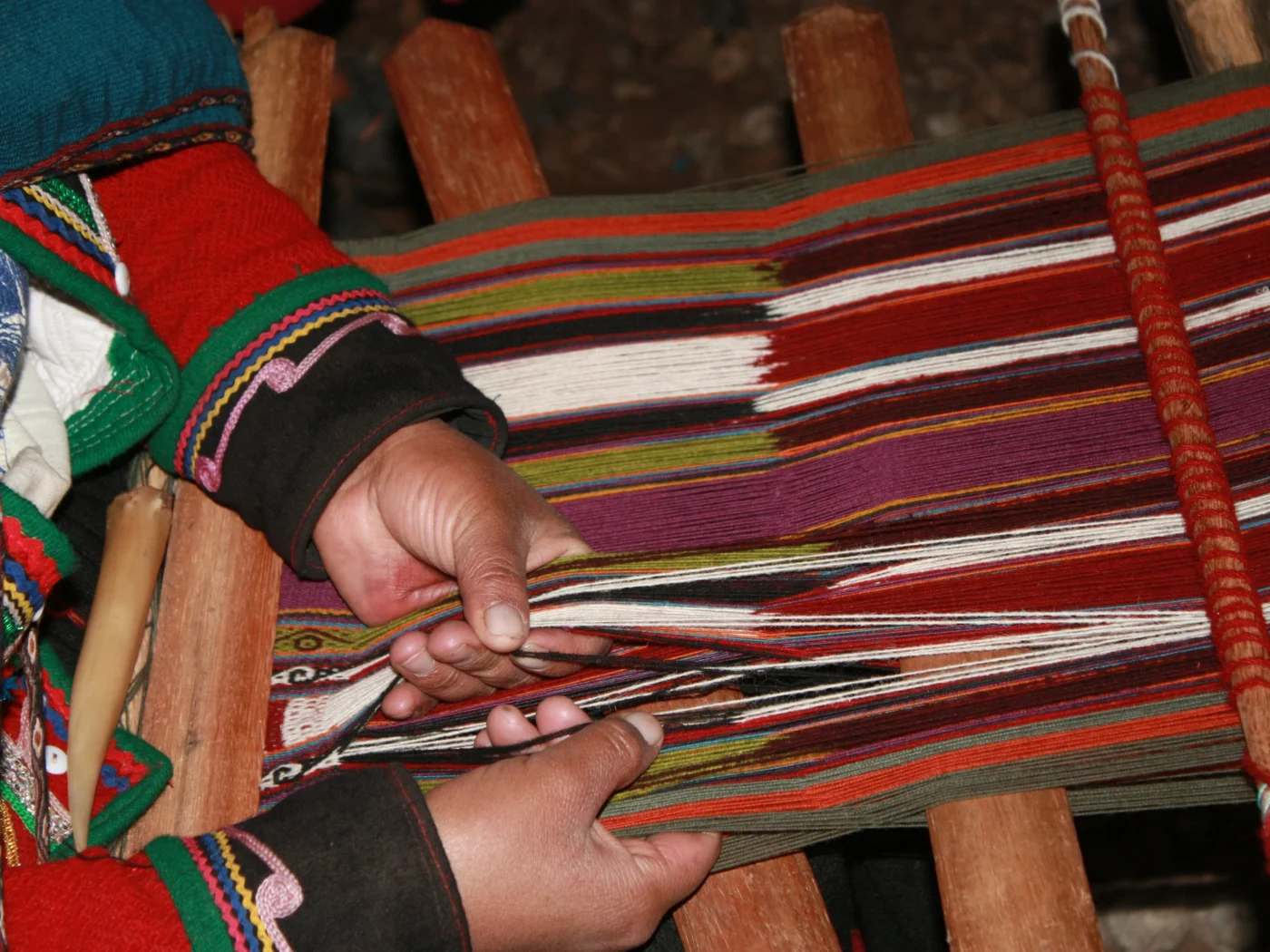
Produce your fashion collection with us
Common Uses in Fashion
Ikat fabric’s unique patterns and vibrant colors make it a popular choice in various fashion applications. Its versatility and rich cultural heritage lend themselves to both traditional and contemporary designs. Here are some of the most common uses of Ikat fabric in fashion:
- Clothing: Ikat is widely used for dresses, skirts, blouses, and shirts. Its beautiful, handwoven designs make it a popular choice for both casual and formal wear. The fabric’s ability to add texture and color makes it ideal for creating statement pieces in a wardrobe.
- Accessories: Ikat is commonly used in fashion accessories such as scarves, shawls, handbags, and belts. Its distinctive patterns add a touch of artistry and elegance to these items, making them standout accessories.
- Home Décor: Beyond clothing, Ikat fabric is also used in home décor items like cushions, upholstery, and curtains. The fabric’s rich patterns and texture bring a unique touch to interiors, adding color and cultural significance.
- Traditional and Ethnic Wear: In countries like India, Indonesia, and Central Asia, Ikat continues to be used for traditional garments such as sarongs, kimonos, and shawls. These garments are often worn during cultural festivals, weddings, or ceremonies, showcasing the craftsmanship and cultural heritage of the region.
- Eco-Fashion: As sustainability becomes more important in the fashion industry, Ikat’s handwoven, natural production process makes it a favored material for eco-conscious brands. Its biodegradable nature and the labor-intensive process appeal to consumers looking for environmentally friendly alternatives to mass-produced textiles.

Understanding the Environmental Impact of Ikat Fabric
Ikat fabric, made from natural fibers like cotton, silk, or wool, is biodegradable, making it more eco-friendly than synthetic fabrics like polyester. However, its environmental impact includes:
- Dyeing Process: Traditional dyeing can be water-intensive and may use synthetic dyes, but eco-friendly practices are emerging.
- Labor-Intensive Production: The handwoven, slow-production process reduces industrial manufacturing, lowering its carbon footprint.
- Water Usage: Dyeing requires significant water, but sustainable techniques are being developed to reduce consumption.
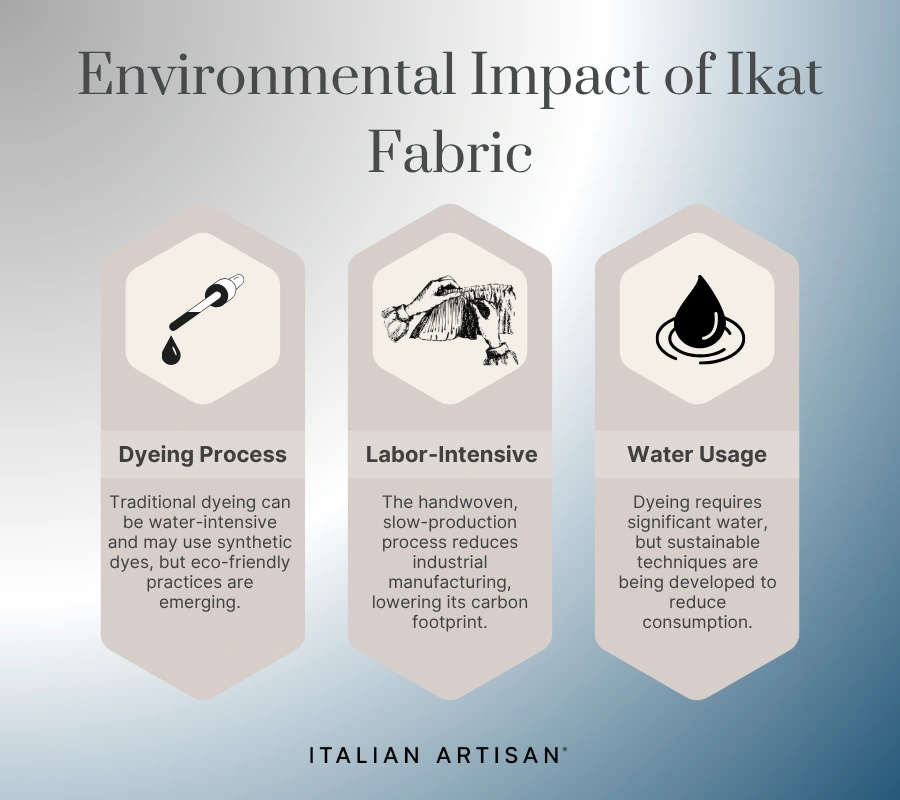
Exploring Price Points and Value for Money
Ikat fabric tends to be more expensive than conventional fabrics due to its labor-intensive production process and the skill required to dye and weave the yarns. However, it offers excellent value for money considering its unique qualities, durability, and cultural significance. Here’s a breakdown of what influences the price of Ikat fabric:
- Labor-Intensive Production: The process of tying, dyeing, and hand-weaving Ikat requires skilled artisans, making it more costly than mass-produced fabrics. This adds to the fabric’s value, as each piece is crafted with precision and care.
- Material Choice: Ikat is made from natural fibers such as cotton, silk, and wool, with silk Ikat being the most expensive due to the luxury of the material itself. The type of fiber used can significantly affect the fabric’s price.
- Craftsmanship and Design: The complexity of the patterns, the number of dyeing stages, and the skill level of the weaver all contribute to the price. The more intricate the design, the higher the cost.
- Sustainability and Rarity: As a sustainable, handcrafted fabric, Ikat can be more expensive than synthetic options, but it offers value in terms of unique, high-quality craftsmanship. Its rarity and cultural significance can also add to its appeal.
Conclusion
Ikat fabric is a unique, versatile textile known for its intricate patterns and rich history. Made from natural fibers like cotton, silk, and wool, it offers durability, texture, and eco-friendly appeal.

While Ikat’s labor-intensive production makes it more expensive than other fabrics, its craftsmanship, sustainability, and cultural significance make it a valuable investment. As demand for sustainable fashion grows, Ikat’s eco-friendly qualities and distinct design continue to attract attention.
- Unique patterns and handcrafted craftsmanship make Ikat stand out.
- Eco-friendly and sustainable, appealing to conscious consumers.
- Higher cost reflects its quality, but it offers great value for its design and durability.
Ikat remains a timeless fabric, combining tradition, artistry, and sustainability for both fashion and home décor.
FAQs
1. What is Ikat fabric made of?
Ikat fabric is made from natural fibers such as cotton, silk, and wool. The fibers are dyed before being woven, creating intricate patterns.
2. How is Ikat fabric different from other fabrics?
Ikat is unique because of its dyeing process, where yarns are dyed before weaving. This results in its characteristic blurred, intricate patterns, unlike fabrics like cotton or polyester that are uniformly dyed.
3. Is Ikat fabric eco-friendly?
Yes, Ikat fabric is made from natural fibers, and its production is more sustainable compared to synthetic fabrics. However, its dyeing process can be water-intensive, though eco-friendly practices are being adopted.
4. Why is Ikat fabric more expensive?
Ikat is labor-intensive to produce, requiring skilled artisans to tie, dye, and weave the fabric. The use of natural fibers like silk or wool also increases its cost.
5. Can Ikat fabric be used for clothing?
Yes, Ikat is commonly used in clothing such as dresses, skirts, blouses, and shirts. It is also popular for accessories like scarves and bags.
6. How should Ikat fabric be cared for?
Ikat fabric should be hand-washed or machine-washed on a gentle cycle with cold water. It’s recommended to air dry to maintain its texture and vibrancy.
7. Is Ikat fabric durable?
Yes, Ikat fabric made from natural fibers like cotton, silk, and wool is durable, although it requires careful handling due to its intricate dyeing.
8. What are the common uses of Ikat fabric?
Ikat is used in clothing, accessories, and home décor. It is especially popular in traditional garments, modern fashion, and interior design for its unique look.
9. Is Ikat fabric only used for traditional clothing?
No, while it is often used for traditional garments, Ikat is also widely used in contemporary fashion, home textiles, and eco-friendly fashion lines.
10. Can Ikat fabric be dyed or printed on?
Ikat fabric can be dyed, and while it already has intricate patterns from the dyeing process, it can also be printed on for additional design elements.




